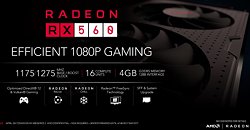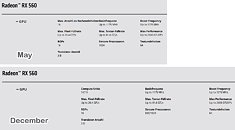Raevenlord
News Editor
- Joined
- Aug 12, 2016
- Messages
- 3,755 (1.20/day)
- Location
- Portugal
| System Name | The Ryzening |
|---|---|
| Processor | AMD Ryzen 9 5900X |
| Motherboard | MSI X570 MAG TOMAHAWK |
| Cooling | Lian Li Galahad 360mm AIO |
| Memory | 32 GB G.Skill Trident Z F4-3733 (4x 8 GB) |
| Video Card(s) | Gigabyte RTX 3070 Ti |
| Storage | Boot: Transcend MTE220S 2TB, Kintson A2000 1TB, Seagate Firewolf Pro 14 TB |
| Display(s) | Acer Nitro VG270UP (1440p 144 Hz IPS) |
| Case | Lian Li O11DX Dynamic White |
| Audio Device(s) | iFi Audio Zen DAC |
| Power Supply | Seasonic Focus+ 750 W |
| Mouse | Cooler Master Masterkeys Lite L |
| Keyboard | Cooler Master Masterkeys Lite L |
| Software | Windows 10 x64 |
AMD has come forward with a statement regarding the state of things as it purports to the recent RX 560 downgrade issue, which has been covered extensively by media outlets just this week. The issue stems from the fact that there was no clear differentiator between two different versions of AMD's RX 560 graphics card, which could ship with two different levels of performance: one with 14 CUs (Compute Units) enabled (896 stream processors) or 16 (1024 stream processors, the original specification for the card).
"It's correct that 14 Compute Unit (896 stream processors) and 16 Compute Unit (1024 stream processor) versions of the Radeon RX 560 are available," stated a company representative. "We introduced the 14 CU version this summer to provide AIBs and the market with more RX 500 series options. It's come to our attention that on certain AIB and e-tail websites there's no clear delineation between the two variants. We're taking immediate steps to remedy this: we're working with all AIB and channel partners to make sure the product descriptions and names clarify the CU count, so that gamers and consumers know exactly what they're buying. We apologize for the confusion this may have caused."


While it's true that AMD is now dealing with the situation openly, the company itself isn't completely blameless on the issue. AMD's own RX 560 product page lists the two possible configurations (14 and 16 CU) absent of any further differentiation in product name. At the same time, AMD could have better enforced differentiation opportunities with its AIB partners upon supplying them with both versions of the GPU. As it stands, some users have been unwittingly buying a lower performing part than what was initially advertised by AMD. While this new transparent stance from AMD is refreshing, it doesn't do much regarding already affected customers. Of course, if users suspect or want to check whether or not they have purchased the higher performance version of the card (16 CUs), they can perform a GPU verification with TechPowerUp's GPU-Z tool.
View at TechPowerUp Main Site
"It's correct that 14 Compute Unit (896 stream processors) and 16 Compute Unit (1024 stream processor) versions of the Radeon RX 560 are available," stated a company representative. "We introduced the 14 CU version this summer to provide AIBs and the market with more RX 500 series options. It's come to our attention that on certain AIB and e-tail websites there's no clear delineation between the two variants. We're taking immediate steps to remedy this: we're working with all AIB and channel partners to make sure the product descriptions and names clarify the CU count, so that gamers and consumers know exactly what they're buying. We apologize for the confusion this may have caused."


While it's true that AMD is now dealing with the situation openly, the company itself isn't completely blameless on the issue. AMD's own RX 560 product page lists the two possible configurations (14 and 16 CU) absent of any further differentiation in product name. At the same time, AMD could have better enforced differentiation opportunities with its AIB partners upon supplying them with both versions of the GPU. As it stands, some users have been unwittingly buying a lower performing part than what was initially advertised by AMD. While this new transparent stance from AMD is refreshing, it doesn't do much regarding already affected customers. Of course, if users suspect or want to check whether or not they have purchased the higher performance version of the card (16 CUs), they can perform a GPU verification with TechPowerUp's GPU-Z tool.
View at TechPowerUp Main Site
Last edited:







